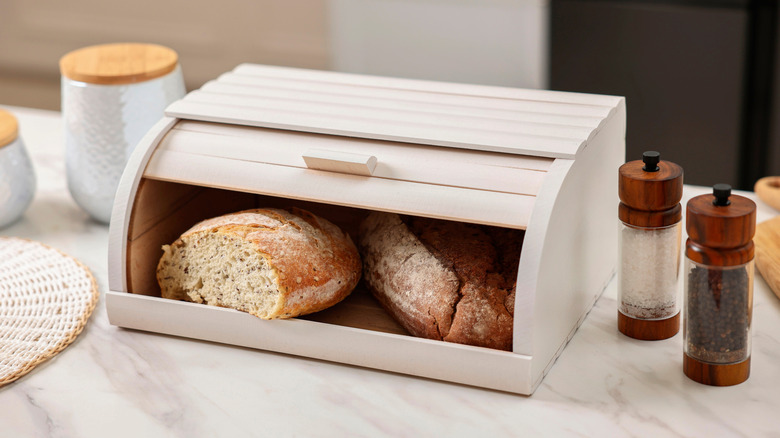The Best Way To Store Homemade Bread So It Stays Fresh
We may receive a commission on purchases made from links.
Homemade bread deserves better than going stale after one day on the counter. Because it doesn't have the preservatives found in most store-bought loaves, it can get dry or moldy surprisingly fast if not stored correctly. Luckily, a little know-how can keep your fresh-baked efforts soft and flavorful for days. Whether you're working with a crusty sourdough, a tender sandwich loaf, or a rustic boule, some savvy storage tips can keep your bread fresh for longer.
No one knows bread better than Sheena Otto, executive baker at Sheena's Cocina in Brooklyn's Park Slope. Otto told us, "The best container will retain moisture without encouraging the growth of mold," adding, "I personally use a breadbox at home, which seems fussy to the uninitiated, but after all the effort you put into baking your bread, why wouldn't you want to preserve its quality for as long as possible?" We concur; a breadbox keeps bread fresh and isn't just for looks.
If you plan to eat the bread within a few days, aside from a breadbox, the best option is beeswax food storage wraps. These methods allow the bread to breathe, which preserves the crust while keeping the interior from drying out too fast. Avoid storing your bread in parts of the kitchen that give off heat, like near ovens or dishwashers. It is also important to avoid plastic wrap or bags unless you want to soften the crust; plastic traps moisture, which can make the crust rubbery and encourage mold. Just be aware that regardless of how you store your fresh bread, it will begin to dry out after a few days, which is perfect timing for toast, bread pudding, or homemade croutons.
Freeze fresh bread for long-term storage
So your loaf has been in the breadbox for a couple of days, but you'd like to keep your bread around a little longer. Should you pop it in the fridge to keep it safe? "Never," Otto sternly warns. "Refrigerator temperatures accelerate the staling process. Room temperature or freezer only." The refrigerator might seem like a good choice, but for most bread, it's not. Cool temperatures (just above freezing) actually stale bread faster by causing the starches to recrystallize. Your bread will go hard and dry in record time. The exception? Very, very humid climates. In those cases, it may be safer to refrigerate bread to stall mold growth. Always wrap it tightly to prevent it from drying out, and toast it before eating to revive the texture.
To freeze food like the professionals do, Otto recommends cutting the bread into slices and wrapping each piece in plastic wrap. This isn't just extra work. "This will make it easier to remove slices as you want them without having to defrost the whole loaf, because remember: Every time the loaf enters/exits refrigerator temperatures as it freezes/defrosts, it will accelerate the staling process," Otto explains. Don't keep that rustic boule in there forever, though. Otto says that the quality begins to decline after about a month. Homemade bread may not last forever, but with these tips, you can enjoy its freshness a little longer.

